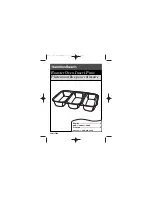
Downloaded from www.vandenborre.be
• The use of a gas cooking appliance cause heat and
moisture in the room in which it is installed. Make sure
that ventilation in the kitchen is good: keep natural
ventilation holes open or install a mechanical ventila-
tion device (mechanical extractor hood).
• More ventilation (for example opening of a window or
increasing the level of mechanical ventilation where
present) is necessary when you operate the appliance
intensively for a long time .
Use
• Only use the appliance for domestic cooking tasks. Do
not use the appliance for commercial and industrial
use. This is to prevent physical injury to persons or
prevent damage to property.
• Always monitor the appliance during operation.
• Always stay away from the appliance when you open
the door while the appliance is in operation. Hot steam
can release. There is a risk of burns.
• Do not use this appliance if it is in contact with water.
Do not operate the appliance with wet hands.
• Do not use the appliance as a work surface or storage
surface.
• The cooking surface of the appliance becomes hot dur-
ing use. There is a risk of burns. Do not put metallic
objects, for example cutlery or saucepans lids, on the
surface, as they can become hot.
• The interior of the appliance becomes hot during use.
There is a risk of burns. Use gloves when you insert or
remove the accessories or pots.
• Open the door carefully. The use of ingredients with al-
cohol can cause a mixture of alcohol and air. There is
the risk of fire.
• Do not let sparks or open flames come near the appli-
ance when you open the door.
• Do not put flammable products or items that are wet
with flammable products, and/or fusible objects (made
of plastic or aluminium) in, near or on the appliance.
There is a risk of explosion or fire.
• Set the cooking zones to "off" after each use.
• Do not use the cooking zones with empty cookware or
without cookware
• Do not let cookware boil dry. This can cause damage to
the cookware and hob surface.
• If an object or cookware falls on the hob surface, the
surface can be damaged.
• Do not put hot cookware near to the control panel be-
cause the heat can cause a damage to the appliance.
• Be careful when you remove or install the accessories
to prevent damage to the appliance enamel.
• Cookware made of cast iron, cast aluminium or with
damaged bottoms can scratch the hob surface if you
move them on the surface.
• Discoloration of the enamel has no effect on the per-
formance of the appliance.
• To prevent damage or discoloration to the enamel:
– do not put any objects directly on the appliance
floor and do not cover it with aluminium foil;
– do not put hot water directly into the appliance;
– do not keep moist dishes and food in the appliance
after you finish the cooking.
• Do not apply pressure on the open door.
• Do not put flammable materials in the compartment be-
low the oven. Keep there only heat-resistant accesso-
ries (if applicable).
• Do not cover oven steam outlets. They are at the rear
side of the top surface (if applicable).
• Use only stable cookware with the correct shape and
diameter to prevent accidental tilting or spilling. There
is a risk of burns.
Lid
• The lid protects the appliance from dust when closed
and collects splashes of grease when opened. Do not
use it for other functions.
• Keep the lid clean all the time.
• Make sure that the appliance is cold before you close
the lid.
• Glass lids can shatter when hot.
Care and cleaning
• Before maintenance, make sure that the appliance is
cold. There is a risk of burns. There is a risk that the
glass panels can break.
• Keep the appliance clean at all times. A build-up of fats
or other foodstuff can result in a fire.
• Regular cleaning prevents the surface material from de-
teriorating.
• For your personal safety and the safety of your proper-
ty, only clean the appliance with water and soap. Do
not use flammable products or products that can cause
corrosion.
19
















































